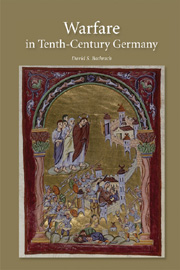Book contents
- Frontmatter
- Contents
- List of Illustrations
- Acknowledgments
- Abbreviations
- Introduction
- 1 Restoring Francia Orientalis: Henry I's Long Term Strategy
- 2 Forging a New Empire
- 3 Military Organization
- 4 Military Education
- 5 Arms and Training
- 6 Morale
- 7 Tactics on the Battlefield
- 8 Campaign Strategy: The Civil War of 953–954
- Conclusion
- Appendix: Major Military Operations by Henry I, Otto I, and Their Commanders
- Bibliography
- Index
- Warfare in History
5 - Arms and Training
Published online by Cambridge University Press: 05 February 2013
- Frontmatter
- Contents
- List of Illustrations
- Acknowledgments
- Abbreviations
- Introduction
- 1 Restoring Francia Orientalis: Henry I's Long Term Strategy
- 2 Forging a New Empire
- 3 Military Organization
- 4 Military Education
- 5 Arms and Training
- 6 Morale
- 7 Tactics on the Battlefield
- 8 Campaign Strategy: The Civil War of 953–954
- Conclusion
- Appendix: Major Military Operations by Henry I, Otto I, and Their Commanders
- Bibliography
- Index
- Warfare in History
Summary
Ottonian military commanders understood very well that effective military operations depended fundamentally on deploying men who had been trained in both combat techniques and tactics. The Bible, which formed a central part of education of men destined for service in either high ecclesiastical or secular office, provided numerous reminders that systematic and ongoing training was crucial for the conduct of war. A number of psalms speak directly to the question of military training. Thus, for example, Psalm 18, echoing 2 Samuel 22:35, presents King David as thanking God for training his hands for battle so that he has the strength to draw his bow. Psalm 144:1 calls blessings upon God who teaches my hands for war and trains my fingers to fight. This particular psalm seems to have had particular resonance with military men. In the early eleventh century, the north Italian count, Ragenardus, had the text of this passage stitched into a battle flag (vexillum) that also featured images of the archangels Michael and Gabriel.
Diligent readers and auditors of the Bible would also learn from 2 Samuel 1:18, which was understood by readers of the Latin Vulgate to be the second book of Kings, that David required the children of Judah be taught to use the bow. Perhaps the best known story, however, is that of David and Goliath, recounted in 1 Samuel 17, where David's lack of training as a soldier (17: 33, 39) is described, and used to explain both the concern that Saul had in sending him into battle, and David's inability to use the sword and armor that were provided to him.
- Type
- Chapter
- Information
- Warfare in Tenth-Century Germany , pp. 135 - 168Publisher: Boydell & BrewerPrint publication year: 2012

